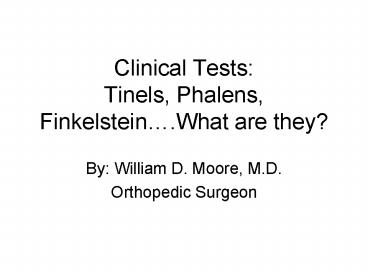Clinical Tests: Tinels, Phalens, Finkelstein.What are they - PowerPoint PPT Presentation
1 / 34
Title:
Clinical Tests: Tinels, Phalens, Finkelstein.What are they
Description:
A proactive test in which flexion of the thumb and ulnar deviation of the wrist ... Impingement Test. Speed's Test ... Speed's Test. Yergason's Test ... – PowerPoint PPT presentation
Number of Views:422
Avg rating:3.0/5.0
Title: Clinical Tests: Tinels, Phalens, Finkelstein.What are they
1
Clinical Tests Tinels, Phalens,
Finkelstein.What are they?
- By William D. Moore, M.D.
- Orthopedic Surgeon
2
Clinical Examination is Very Important
- The clinical examination of a patient along with
their history is very important in forming a
diagnosis and treatment plan. - Diagnostic imaging must be correlated with
clinical exam findings.
3
Tests for Forearm, Wrists Hands
- Tinels Test
- Carpal Compression Test
- Finkelsteins Test
4
Tinels Test
- The examiner taps over the carpal tunnel at the
wrist. A positive test causes tingling or
paresthesia into the thumb, index finger, and
middle and lateral half of the ring.
5
Tinels Test
6
Carpal Compression Test
- The examiner holds the supinated wrist in both
hands and applies direct, even pressure over the
median nerve in the carpal tunnel for up to 30
seconds.
7
Carpal Compression Test
8
Finkelsteins Test
- A proactive test in which flexion of the thumb
and ulnar deviation of the wrist are used to
elicit the pain of de Quervains tenosynovitis.
9
Finkelsteins Test
10
Test for the Shoulder Biceps
- Hawkins Impingement Test
- Neer Impingement Test
- Empty Can Test
- Cross-arm Adduction Impingement Test
- Speeds Test
- Yergasons Test
11
Hawkins Impingement Test
- A test for rotator cuff impairment in which the
shoulder is flexed 90 degrees and maximally
internally rotated.
12
Hawkins Impingement Reinforcement Test
13
Neers Impingement Sign
- The production of pain by maximal passive forward
flexion of the shoulder, considered a sign of
rotator cuff impingement.
14
Neers Impingement Sign
15
Empty Can
- A resistive test for the shoulder, designed to
isolate supraspinatus function as much as
possible, performed with the shoulder in a
position of 90 degrees abduction and maximal
internal rotation in a plane 30 degrees anterior
to the coronal plane.
16
Empty Can
17
Cross-arm Adduction Impingement Test
- This test uses the position of cross-arm or
horizontal adduction to produce contact between
the rotator cuff and biceps long-head tendon and
the coracoacromial arch.
18
Cross-arm Adduction Impingement Test
19
Speeds Test
- A provocative test for biceps tendon pain in
which the shoulder is flexed against resistance
with the forearm supinated.
20
Speeds Test
21
Yergasons Test
- A provocative test for biceps tendon pain in
which the patient is asked to simultaneously flex
the elbow and supinate the forearm against
resistance.
22
Yergasons Test
23
Knee Tests
- Apleys Test
- McMurry Test
- Anterior Drawer Sign
- Lachmans Test
- Posterior Drawer Sign
- Posterior Sag Sign
24
Apleys Test
- A provocative test to elicit the pain associated
with a meniscus tear by compression and rotating
the knee in the 90 degrees flexed position.
25
Apleys Test
26
McMurray Test
- A provocative test to elicit pain and clicking
associated with a torn meniscus by passively
manipulating a hyperflexed knee.
27
McMurray Test
28
Anterior Drawer Sign
- A manipulation test to detect abnormal anterior
laxity of the knee in the 90 degrees flexed
position primarily a test of anterior cruciate
ligament (ACL) integrity.
29
Anterior Drawer Sign
Anterior Drawer in sitting in position. Examiner
feels anterior shift
Examiner watches for anterior shift.
30
Lachmans Test
- A manipulative test for detecting abnormal
anterior laxity in the knee performed in a
position of mild flexion primarily a test of
anterior cruciate ligament (ACL) integrity.
31
Lachmans Test
32
Posterior Sag Sign
- With the knee flexed at 90 degrees, it causes the
tibia to drop or sag back on the femur because of
gravity, if the posterior cruciate ligament (PCL)
is torn.
33
Posterior Sag Sign
34
Waddell Signs
- Hoover Test
- Straight leg raise (seated vs. supine)
- Non-Anatomic distribution of weakness/numbness
- Trunkal Rotation
- Occipital Compression
- Over reaction to light stimulus

